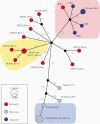Exportation of Monkeypox Virus From the African Continent
- PMID: 32880628
- PMCID: PMC9016419
- DOI: 10.1093/infdis/jiaa559
Exportation of Monkeypox Virus From the African Continent
Abstract
Background: The largest West African monkeypox outbreak began September 2017, in Nigeria. Four individuals traveling from Nigeria to the United Kingdom (n = 2), Israel (n = 1), and Singapore (n = 1) became the first human monkeypox cases exported from Africa, and a related nosocomial transmission event in the United Kingdom became the first confirmed human-to-human monkeypox transmission event outside of Africa.
Methods: Epidemiological and molecular data for exported and Nigerian cases were analyzed jointly to better understand the exportations in the temporal and geographic context of the outbreak.
Results: Isolates from all travelers and a Bayelsa case shared a most recent common ancestor and traveled to Bayelsa, Delta, or Rivers states. Genetic variation for this cluster was lower than would be expected from a random sampling of genomes from this outbreak, but data did not support direct links between travelers.
Conclusions: Monophyly of exportation cases and the Bayelsa sample, along with the intermediate levels of genetic variation, suggest a small pool of related isolates is the likely source for the exported infections. This may be the result of the level of genetic variation present in monkeypox isolates circulating within the contiguous region of Bayelsa, Delta, and Rivers states, or another more restricted, yet unidentified source pool.
Keywords: border health; exportation; haplotype networks; monkeypox virus; travel epidemiology; viral genomes.
© The Author(s) 2020. Published by Oxford University Press for the Infectious Diseases Society of America.
Figures




References
-
- World Health Organization. Monkeypox fact sheet. https://www.who.int/news-room/fact-sheets/detail/monkeypox. Accessed 1 April 2020.
-
- Essbauer S, Meyer H. Genus Orthopoxvirus: Monkeypox virus. In: Poxviruses. Basel, Switzerland: Birkhäuser, 2007:65–73.
-
- Learned LA, Reynolds MG, Wassa DW, et al. . Extended interhuman transmission of monkeypox in a hospital community in the Republic of the Congo. Am J Trop Med Hyg 2003. 2005; 73:428–34. - PubMed
MeSH terms
Grants and funding
LinkOut - more resources
Full Text Sources
Medical

